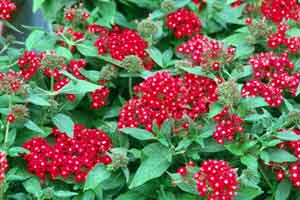Information Possibly Outdated
The information presented on this page was originally released on April 23, 2001. It may not be outdated, but please search our site for more current information. If you plan to quote or reference this information in a publication, please check with the Extension specialist or author before proceeding.
Butterfly Pentas win MS Medallion award
By Norman Winter
MSU Horticulturist
Central Mississippi Research & Extension Center
Butterflies, hummingbirds and gardeners will love the Mississippi Medallion award-winning Butterfly pentas. This group, or series, of herbaceous plants proved almost conclusively that butterflies not only have a unique flying ability but also an underrated intelligence. Apparently, butterflies can read.
In the trials, there were several series of pentas including the old standards. Pentas have long been known as a great source of nectar for butterflies. As the butterfly season reached its peak and the pentas trial developed into a sea of color, it astounded everyone to see the butterflies skipping the old standards to feast on the clearly marked Butterfly series almost exclusively.

The Butterfly pentas are the first F1 hybrid series of pentas. This means gardeners get a vigorous plant with better blooming and uniformity.
Pentas are great bedding plants for the South and are considered a sub-shrub in Africa. While we call them pentas, much of the world calls them Egyptian Star Cluster. In fact, the name pentas comes from the Latin word for five because of the five floral petals.
The Butterfly series gives a lush tropical look to the garden. They are available in five colors: Butterfly Red, Blush, Light Lavender, Deep Pink and Cherry Red. Blooms will be produced in abundance and all summer long if bed preparation is done correctly. Place them in a bed in front of evergreen shrubs like hollies, ligustrums, wax myrtles or junipers.
Choose a site in full sun for best flower productions. Prepare the bed by incorporating 3 to 4 inches of organic matter and till to a depth of 8 to 10 inches. While tilling, incorporate two pounds of a slow-release, 12-6-6 fertilizer.
The next step may be the most crucial to happiness with your pentas. If your soil is acidic and you grow azaleas, camellias or blueberries with ease, then you will need to add lime to your pentas' planting area. While preparing the soil, add five pounds of a pelletized lime per 100 square feet in sandy soil, or 10 pounds in a clay-based soil. This is recommended because pentas prefer a soil pH of 7.
Many gardeners annually apply lime to grass or vegetable gardens, and in this case, a little will help the pentas have flowers all summer. By the way, they're great in the vase as cut flowers.
While shopping for plants this spring, look for the colorful point-of-sale material showing your Mississippi Medallion winners. Look not only for the Butterfly pentas, but also for other 2001 award winners like the Kathy Ann yaupon holly and the Burgundy loropetalum. Keep in mind also that previous winners such as New Wonder scaevola or Biloxi Blue verbena are still winners too and serve your landscape well.






